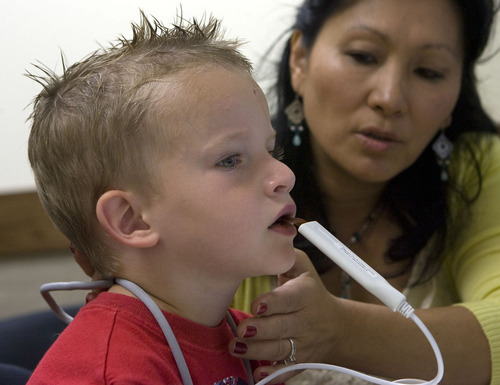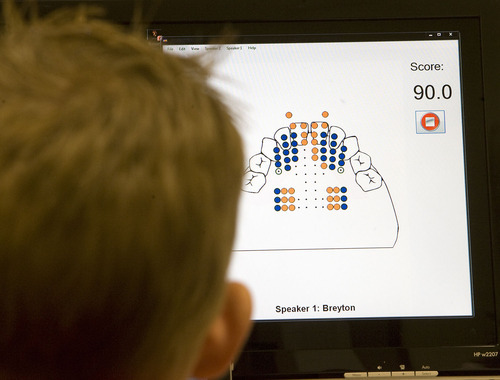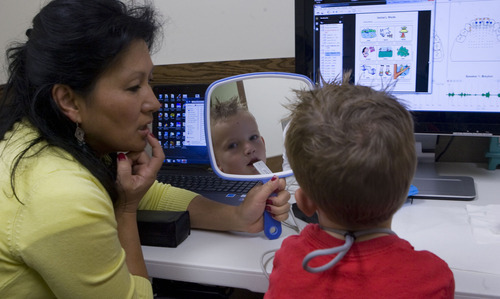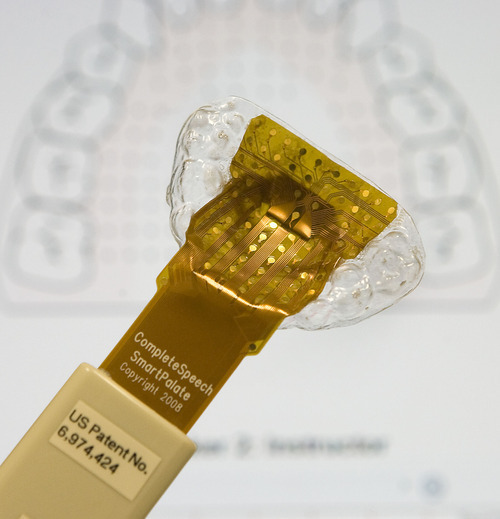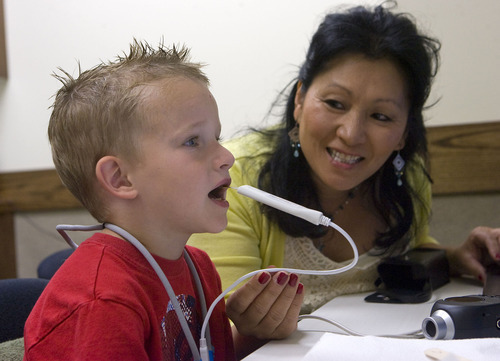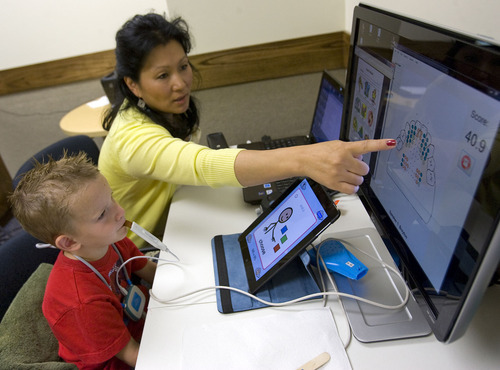This is an archived article that was published on sltrib.com in 2011, and information in the article may be outdated. It is provided only for personal research purposes and may not be reprinted.
About half of all speech therapy takes place in schools, but not all the children who could benefit from help get it, says the CEO of a Utah company now marketing a device long used in speech research.
"If they have a speech problem that's not affecting their grades, [the schools] don't see it as a problem," said Andy May of CompleteSpeech in Orem. "A kid whose grades are good but he's a social outcast because of his speech difficulties, that is a problem."
CompleteSpeech says its technology can help children learn more quickly than traditional speech therapy, and is hoping school districts and speech pathologists adopt it.
Its system is based on customized mouthpieces called palatometers. Embedded in the palatometers are 124 sensors that monitor how a speaker's tongue touches her palate when she talks. A microprocessor links the mouthpiece to a computer screen that the speaker and therapist can watch and use to make corrections in real time.
The basic technology has been around since 1930. In the late 1960s, Utah professor Samuel Fletcher teamed up with an Edinburgh academic to develop a palatometer. Two other labs in Japan and the United States also developed devices that have been used in research and university settings.
Fletcher started a company called LogoMetrix, but wasn't able to make palatometers practical for commercial use. May, a mechanical engineer, saw Fletcher's equipment through Brigham Young University's Tapstone program, which teams engineering students with companies to solve problems. He worked with Fletcher to adapt and license new, more affordable technology.
May said CompleteSpeech has done some test marketing, but with its rollout announcement now is reaching out to school districts in Utah, Idaho and Wyoming.
One Wyoming district, in Lincoln County's Star Valley, already has enrolled. The district's speech language pathologist, Jody Fletcher, said she encountered palatometers during her graduate-school training. In her Web search for equipment her schools might use, she encountered the CompleteSpeech website.
After May gave a presentation to the district's special education director, the district signed up for two packages that included 10 mouthpieces, two of which they fitted to students this past spring.
Fletcher said she mostly works with children in grades 4 through 6 who have had traditional therapy for years and are past the age where they would just grow out of a problem. "We wait and give the kids a chance with traditional therapy," she said.
Though she was only able to work with her two pupils for a few weeks before school let out, "I've seen improvement in both of my students," Fletcher said. It's important, she said, to "catch them while they're younger, before the [speech] neural pathway is well-formed."
That was Lacy Banks' thinking when she brought her 5-year-old son, Breyton, to Orem speech language pathologist Ann Dorais.
"He was going into kindergarten," Banks said. "We didn't want him to feel he wasn't doing as well as the other kids."
Breyton has received speech therapy since age 3 that has been helpful, but Banks said he hadn't progressed as much as she hoped.
Dorais in 2009 put the CompleteSpeech palatometer to work in her business, A+Speech Therapy.
For $1,500, Dorais provided the dental impressions necessary to craft Breyton's custom mouthpiece, the fittings, 20 therapy sessions spread over five weeks and two follow-up sessions Banks can use any time during the 12-month period after she signed up. Dorais also did initial evaluations, tests and analyses.
After five weeks, Breyton could pronounce the letter s, Banks said, and is taking more care to speak the ends of his words.
"He's made more progress in the past five weeks," Banks said, "than in the last two years."
Dorais said she paid CompleteSpeech $3,000 for the therapeutic apparatus, software, data links and two mouthpieces, one of which she can wear herself. "For some children, it helps them to see me," she said. "Some of the teenagers want a little competition."
Twitter: @sltribhen Electronic palates
Electropalatography — using electrical circuits to monitor how a speaker's tongue hits the palate and teeth — has been used in research and academic settings since 1930, but has been prohibitively expensive.
CompleteSpeech, a Utah company based in Orem, has re-engineered expensive technology into an affordable computerized system for use in schools and private speech-therapy practices.
Learn more at completespeech.com.


